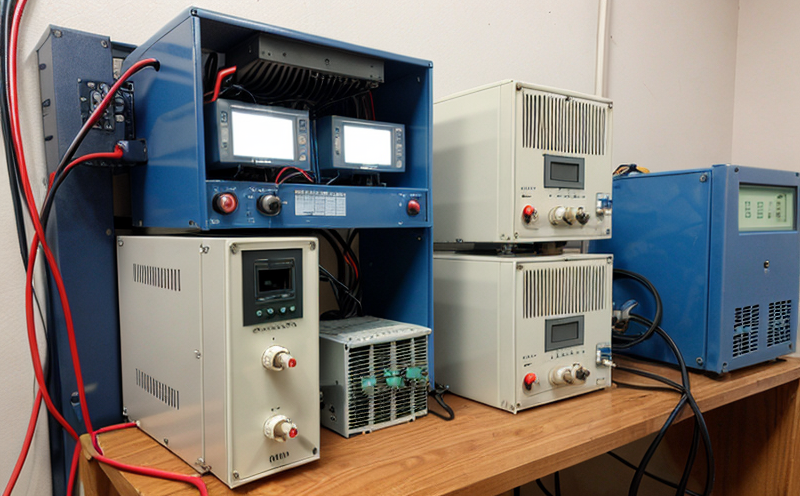UIC 608 Voltage Stability Testing of Power Supply Systems
The UIC 608 standard specifies requirements and test methods to evaluate voltage stability in power supply systems used within railway transportation. This service is crucial for ensuring that the electrical components meet the stringent demands set by international standards, particularly those relevant to railway operations.
Understanding the importance of voltage stability is critical as it directly affects the reliability and safety of railway systems. Voltage fluctuations can lead to malfunctions in signaling equipment, communication devices, and traction systems, which are vital for safe and efficient railway operations. By adhering to UIC 608 standards, railway operators ensure that their power supply systems are robust against such variations.
The testing process involves subjecting the electrical components to a range of voltage conditions that simulate real-world scenarios encountered in railway environments. This includes both steady-state and transient voltage changes, ensuring that the system can maintain stable performance under various operating conditions. The test setup typically consists of specialized equipment capable of generating controlled voltage fluctuations within specified parameters.
During the testing process, detailed data is collected to assess the behavior of the power supply system under different voltage conditions. This includes monitoring current consumption, power factor, and harmonic distortion levels. Compliance with UIC 608 standards ensures that railway infrastructure meets international safety and performance requirements.
The UIC 608 standard also emphasizes the importance of environmental considerations in testing procedures. Factors such as temperature, humidity, and altitude are taken into account to ensure that the test results accurately reflect real-world conditions. This comprehensive approach helps manufacturers develop products that can withstand diverse operating environments while maintaining high levels of performance.
Accurate reporting is a cornerstone of this service, providing clear insights into how well the power supply systems perform under various voltage conditions. Technical reports detail the testing methodology, parameters tested, and results achieved against UIC 608 requirements. These reports serve as valuable tools for quality managers, compliance officers, R&D engineers, and procurement teams in making informed decisions about product design and certification.
Why Choose This Test
Selecting the UIC 608 Voltage Stability Testing service offers several advantages that are particularly beneficial for those involved in railway infrastructure development. Firstly, it ensures compliance with international standards, which is essential for regulatory approval and market access.
- Ensures compliance with UIC 608 requirements
- Aids in securing certification from relevant bodies
- Facilitates smoother integration into existing railway systems
- Reduces the risk of operational disruptions due to non-compliance issues
Secondly, this service provides valuable data that can be used for continuous improvement. By identifying areas where performance falls short of UIC 608 standards, manufacturers and operators can implement targeted improvements, enhancing overall system reliability.
In addition, the test results serve as a benchmark against which future developments can be measured. This helps in maintaining a competitive edge by ensuring that railway systems remain at the forefront of technological advancements.
Environmental and Sustainability Contributions
The UIC 608 Voltage Stability Testing service has significant environmental and sustainability contributions, aligning with broader goals of reducing carbon footprints and enhancing resource efficiency. By ensuring that power supply systems operate efficiently under varying voltage conditions, this testing helps minimize energy waste.
Efficient power utilization not only reduces operational costs but also contributes to lower emissions from railway operations. This is particularly important given the growing emphasis on sustainable transportation solutions worldwide. The test results can guide manufacturers in designing more efficient components, which ultimately lead to better resource management and reduced environmental impact.
The testing process itself is conducted under controlled conditions that mimic real-world scenarios, ensuring accuracy without unnecessary resource consumption. Moreover, the insights gained from these tests help in optimizing system performance, leading to longer operational lifetimes and reduced maintenance requirements. This extended lifecycle translates into lower waste generation and less frequent replacements of components.
Furthermore, by adhering to UIC 608 standards, railway operators contribute positively towards achieving international environmental goals set forth by organizations like the United Nations Environment Programme (UNEP) and the International Railway Union (IRU). These efforts collectively work towards creating a more sustainable future for global transportation systems.
Use Cases and Application Examples
| Use Case | Description |
|---|---|
| Signal Systems | Evaluating the stability of power supply systems powering signal lights and control panels. |
| Communication Equipment | Assessing voltage variations' impact on communication devices used in railway networks. |
| Traction Systems | Determining how changes in voltage affect the performance of traction motors and related equipment. |
| Emergency Power Supply | Testing the reliability of emergency power supplies during blackouts or system failures. |
| Battery Chargers | Ensuring that battery chargers can maintain stable output under fluctuating voltage inputs. |
| Environmental Monitoring Systems | Evaluating the robustness of environmental monitoring systems against voltage fluctuations in harsh conditions. |
- Signal Systems: Ensuring that signals remain accurate even when facing varying power supply conditions.
- Communication Equipment: Verifying that communication devices continue to function properly under unstable voltage environments.
- Traction Systems: Guaranteeing that traction motors and related equipment operate efficiently despite fluctuating voltages.
- Emergency Power Supply: Confirming the reliability of emergency power supplies during critical situations like blackouts or system failures.
- Battery Chargers: Ensuring battery chargers maintain stable output under varying voltage inputs, crucial for uninterrupted power supply in railway operations.
- Environmental Monitoring Systems: Evaluating how environmental monitoring systems perform under harsh conditions with fluctuating voltages.





